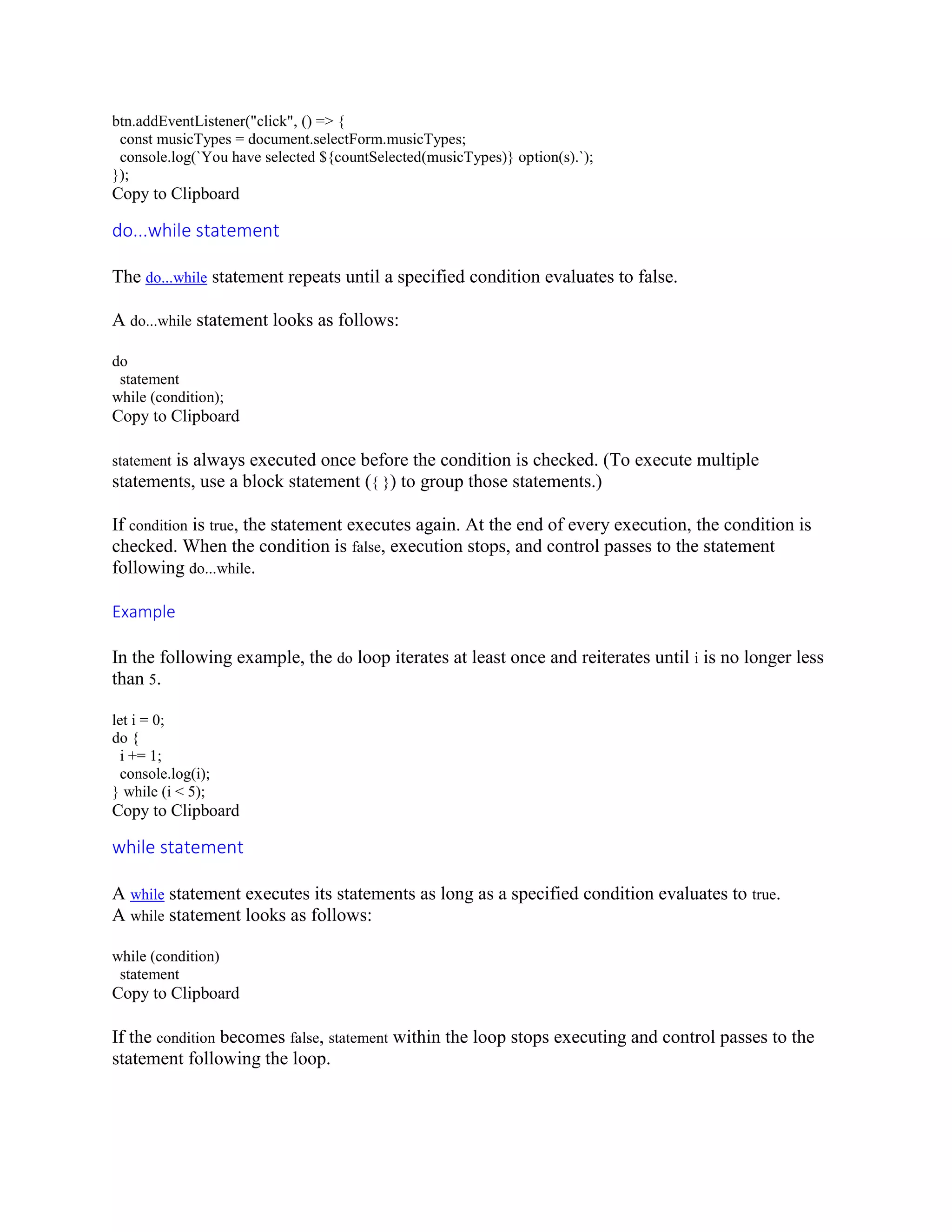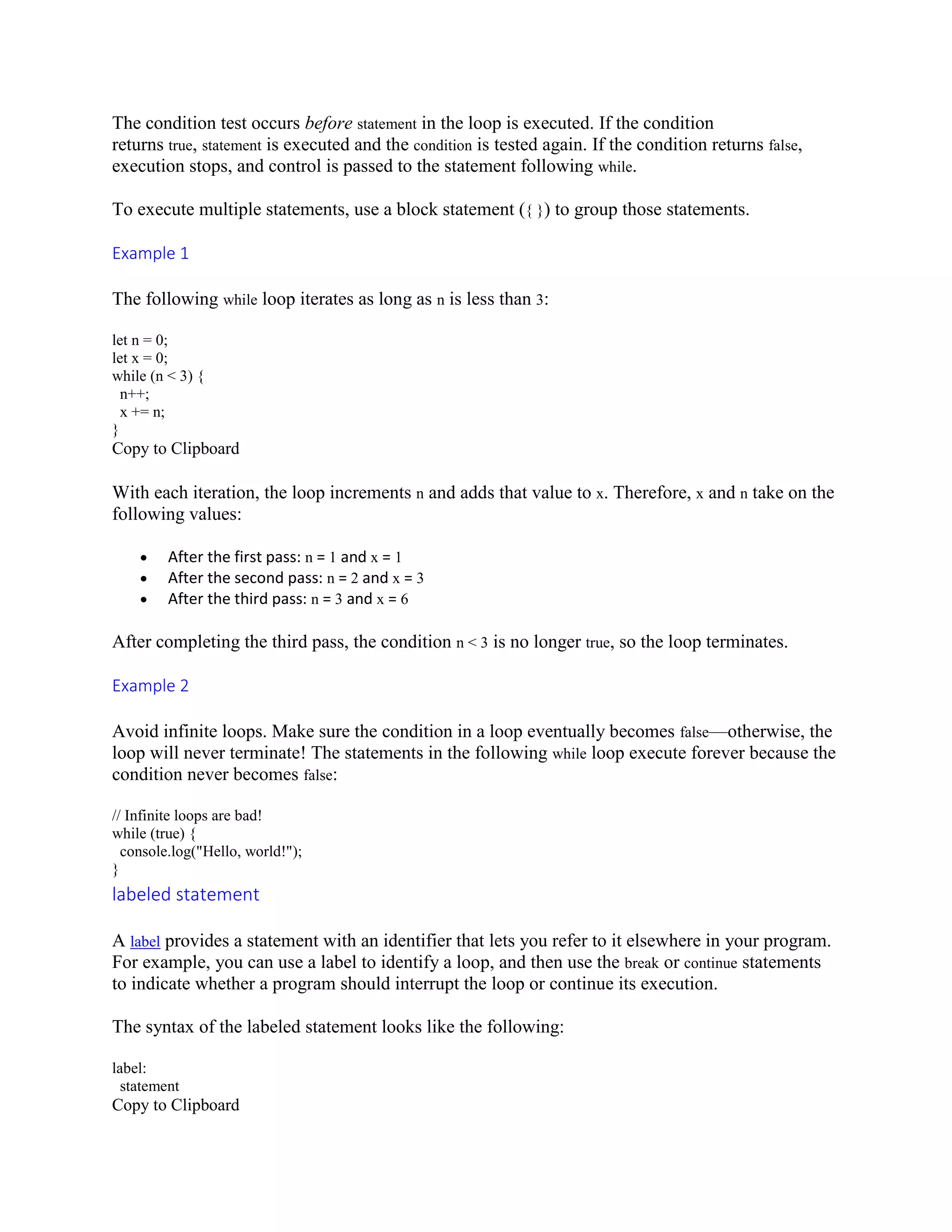The document discusses different types of loops in JavaScript, including for, do-while, while, labeled, break, continue, for-in, and for-of loops. It provides examples and explanations of how each loop type works, when to use each type, and their basic syntax. The key loops are: for loops repeat until a condition is false, do-while loops always run once then repeat while a condition is true, while loops check a condition before each iteration, and break and continue can terminate or skip iterations within a loop.


![1. The initializing expression initialization, if any, is executed. This expression usually initializes one
or more loop counters, but the syntax allows an expression of any degree of complexity. This
expression can also declare variables.
2. The condition expression is evaluated. If the value of condition is true, the loop statements
execute. Otherwise, the for loop terminates. (If the condition expression is omitted entirely, the
condition is assumed to be true.)
3. The statement executes. To execute multiple statements, use a block statement ({ }) to group
those statements.
4. If present, the update expression afterthought is executed.
5. Control returns to Step 2.
Example
In the example below, the function contains a for statement that counts the number of selected
options in a scrolling list (a <select> element that allows multiple selections).
HTML
<form name="selectForm">
<label for="musicTypes"
>Choose some music types, then click the button below:</label
>
<select id="musicTypes" name="musicTypes" multiple>
<option selected>R&B</option>
<option>Jazz</option>
<option>Blues</option>
<option>New Age</option>
<option>Classical</option>
<option>Opera</option>
</select>
<button id="btn" type="button">How many are selected?</button>
</form>
Copy to Clipboard
JavaScript
Here, the for statement declares the variable i and initializes it to 0. It checks that i is less than the
number of options in the <select> element, performs the succeeding if statement, and
increments i by 1 after each pass through the loop.
function countSelected(selectObject) {
let numberSelected = 0;
for (let i = 0; i < selectObject.options.length; i++) {
if (selectObject.options[i].selected) {
numberSelected++;
}
}
return numberSelected;
}
const btn = document.getElementById("btn");](https://image.slidesharecdn.com/loopsanditeration-230304200227-0606f73a/75/Loops-and-iteration-docx-3-2048.jpg)


![The value of label may be any JavaScript identifier that is not a reserved word. The statement that
you identify with a label may be any statement.
Example
In this example, the label markLoop identifies a while loop.
markLoop: while (theMark) {
doSomething();
}
Copy to Clipboard
break statement
Use the break statement to terminate a loop, switch, or in conjunction with a labeled statement.
When you use break without a label, it terminates the innermost enclosing while, do-while, for,
or switch immediately and transfers control to the following statement.
When you use break with a label, it terminates the specified labeled statement.
The syntax of the break statement looks like this:
break;
break label;
Copy to Clipboard
1. The first form of the syntax terminates the innermost enclosing loop or switch.
2. The second form of the syntax terminates the specified enclosing labeled statement.
Example 1
The following example iterates through the elements in an array until it finds the index of an
element whose value is theValue:
for (let i = 0; i < a.length; i++) {
if (a[i] === theValue) {
break;
}
}
Copy to Clipboard
Example 2: Breaking to a label
let x = 0;
let z = 0;
labelCancelLoops: while (true) {
console.log("Outer loops: ", x);
x += 1;
z = 1;
while (true) {
console.log("Inner loops: ", z);](https://image.slidesharecdn.com/loopsanditeration-230304200227-0606f73a/75/Loops-and-iteration-docx-6-2048.jpg)

![Example 2
A statement labeled checkiandj contains a statement labeled checkj. If continue is encountered, the
program terminates the current iteration of checkj and begins the next iteration. Each
time continue is encountered, checkj reiterates until its condition returns false. When false is
returned, the remainder of the checkiandj statement is completed, and checkiandj reiterates until its
condition returns false. When false is returned, the program continues at the statement
following checkiandj.
If continue had a label of checkiandj, the program would continue at the top of
the checkiandj statement.
let i = 0;
let j = 10;
checkiandj: while (i < 4) {
console.log(i);
i += 1;
checkj: while (j > 4) {
console.log(j);
j -= 1;
if (j % 2 === 0) {
continue checkj;
}
console.log(j, " is odd.");
}
console.log("i = ", i);
console.log("j = ", j);
}
Copy to Clipboard
for...in statement
The for...in statement iterates a specified variable over all the enumerable properties of an object.
For each distinct property, JavaScript executes the specified statements. A for...in statement looks
as follows:
for (variable in object)
statement
Copy to Clipboard
Example
The following function takes as its argument an object and the object's name. It then iterates over
all the object's properties and returns a string that lists the property names and their values.
function dumpProps(obj, objName) {
let result = "";
for (const i in obj) {
result += `${objName}.${i} = ${obj[i]}<br>`;
}
result += "<hr>";](https://image.slidesharecdn.com/loopsanditeration-230304200227-0606f73a/75/Loops-and-iteration-docx-8-2048.jpg)
![return result;
}
Copy to Clipboard
For an object car with properties make and model, result would be:
car.make = Ford
car.model = Mustang
Arrays
Although it may be tempting to use this as a way to iterate over Array elements,
the for...in statement will return the name of your user-defined properties in addition to the
numeric indexes.
Therefore, it is better to use a traditional for loop with a numeric index when iterating over
arrays, because the for...in statement iterates over user-defined properties in addition to the array
elements, if you modify the Array object (such as adding custom properties or methods).
for...of statement
The for...of statement creates a loop Iterating over iterable
objects (including Array, Map, Set, arguments object and so on), invoking a custom iteration hook
with statements to be executed for the value of each distinct property.
for (variable of object)
statement
Copy to Clipboard
The following example shows the difference between a for...of loop and a for...in loop.
While for...in iterates over property names, for...of iterates over property values:
const arr = [3, 5, 7];
arr.foo = "hello";
for (const i in arr) {
console.log(i);
}
// "0" "1" "2" "foo"
for (const i of arr) {
console.log(i);
}
// Logs: 3 5 7
Copy to Clipboard
The for...of and for...in statements can also be used with destructur](https://image.slidesharecdn.com/loopsanditeration-230304200227-0606f73a/75/Loops-and-iteration-docx-9-2048.jpg)
![The for...of and for...in statements can also be used with destructuring. For example, you
can simultaneously loop over the keys and values of an object using Object.entries().
const obj = { foo: 1, bar: 2 };
for (const [key, val] of Object.entries(obj)) {
console.log(key, val);
}
// "foo" 1
// "bar" 2](https://image.slidesharecdn.com/loopsanditeration-230304200227-0606f73a/75/Loops-and-iteration-docx-10-2048.jpg)